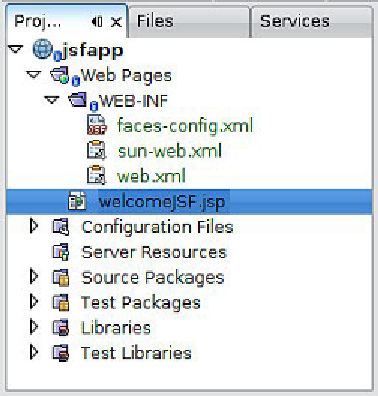Java Reference
In-Depth Information
Unsurprisingly, for JSF applications we need to select the JavaServer
Faces framework.
The Visual Web JavaServer Faces framework allows us to quickly build
web pages by dragging-and-dropping components from the NetBeans
palette into our pages. Although it certainly allows us to develop
applications a lot quicker than manually coding, it hides a lot of the "ins"
and "outs" of JSF. Having a background in standard JSF development will
help us understand what the NetBeans Visual Web functionality does
behind the scenes. Visual Web JSF is covered in Chapter 6.
When clicking
Finish
, the wizard generates a skeleton JSF project for us, consisting
of a single JSP file called
welcomeJSF.jsp
, and a few configuration files:
web.xml
,
faces-config.xml
and, if we are using the default bundled GlassFish server, the
GlassFish specific
sun-web.xml
file is generated as well.
web.xml
is the standard configuration file needed for all Java web applications.
faces-config.xml
is a JSF-specific configuration file used to declare JSF-managed
beans and navigation rules.
sun-web.xml
is a GlassFish-specific configuration file
that allows us to override the application's default context root, add security role
mappings, and perform several other configuration tasks.
















